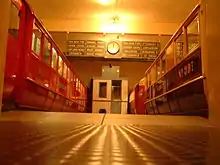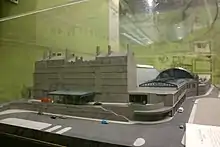Glasgow Museum of Transport
The Glasgow Museum of Transport in Glasgow, Scotland was established in 1964 and initially located at a former tram depot in Pollokshields. In 1987 the museum was relocated to the city's Kelvin Hall, then moved to its current location in the Riverside Museum building at Glasgow Harbour in 2011.
History
The Museum of Transport was opened on 14 April 1964 by Queen Elizabeth The Queen Mother.[1][2] Created in the wake of the closure of Glasgow's tramway system in 1962, it was initially located at the former Coplawhill tram depot on Albert Drive in Pollokshields, before moving to the Kelvin Hall. The old building was subsequently converted into the Tramway arts centre.
The museum was then situated inside the Kelvin Hall opposite the Kelvingrove Art Gallery & Museum in the west end of Glasgow. The Kelvin Hall was built in 1927, originally as an exhibition centre, but was converted in 1987 to house the Museum of Transport and the Kelvin Hall International Sports Arena.
The Kelvin Hall site itself closed in April 2010, with the Museum moving to its third home at the new Riverside Museum in 2011.[3]
Museum of Transport (1987 - 2010)


The Museum of Transport in the Kelvin Hall was one of the most popular museums of transport in the United Kingdom, attracting half a million visitors a year, and housed many exhibits of national and international importance.
Road vehicles
The museum housed the oldest surviving pedal cycle and the world's leading collection of Scottish-built cars and trucks, including pioneering examples from Scottish manufacturers Argyll, Arrol-Johnston and Albion. More modern Scottish-built cars, namely the Rootes Group's Hillman Imp, Chrysler Avenger and Chrysler Sunbeam were represented too along with many other motorcars in a large showroom-type display sponsored by Arnold Clark.
All forms of transport were featured, from horse-drawn vehicles to fire engines, from motorcycles to caravans, even toy cars and prams.
Ship models
In the Clyde Room was a display of some 250 ship models, representing the contribution of the River Clyde and its shipbuilders and engineers to maritime trade and the Royal Navy, including the Comet of 1812, the Hood, the Howe, the Queen Mary, and the Queen Elizabeth and the QE2.
Railway and municipal transport exhibits
Locomotive manufacture was also an important Glasgow industry and the museum celebrated the city's railway heritage, including locomotives such as:
- The Caledonian Railway - Caley No. 123 single driver
- Highland Railway - No. 103, the Jones Goods
- Great North of Scotland Railway - Gordon Highlander No. 49
- Glasgow & South Western Railway - 5 Class 0-6-0T no. 9
- Andrew Barclay 0-6-0 Fireless locomotive, South of Scotland Electricity Board, No. 1
- First ScotRail - Class 380 EMU (full-scale model)

Other main exhibits displayed the evolution of Glasgow's public transport system and included seven Glasgow Corporation Tramways tramcars from different eras, Glasgow Corporation trolleybuses, and the reconstruction of "Kelvin Street", which aimed to recapture the atmosphere of 1930s Glasgow, including full-scale replicas of a pre-1977 Glasgow Subway station and the Regal Cinema, which played Scottish transport documentaries such as Seawards the Great Ships.

Current Museum of Transport
The museum at Kelvin Hall closed on 18 April 2010, with most of its collections moved to the new purpose-built Riverside Museum in Glasgow Harbour on the Clyde, designed by Zaha Hadid Architects and engineers Buro Happold.[4] The new museum opened on Tuesday 21 June 2011.
See also
References
- The Transport Museum Scene Trolley Wire issue 100 October 1965 page 9
- Glasgow Museum Extended The Railway Magazine issue 791 March 1967 pages 124-127
- Transport museum closes before replacement opens BBC News 18 February 2010
- Museum of Transport Glasgow, Glasgow Transport Museum, Zaha Hadid
External links
| Wikimedia Commons has media related to Glasgow Museum of Transport. |

